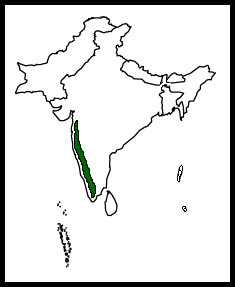| Line 1: | Line 1: | ||
| + | [[Image:Malabar_Parakeet.jpg|thumb|550px|right|Photo by {{user|atanumondal|atanumondal}}<br />Male]] | ||
;[[:Category:Psittacula|Psittacula]] columboides | ;[[:Category:Psittacula|Psittacula]] columboides | ||
| − | |||
==Identification== | ==Identification== | ||
A medium sized blue-greenish Parakeet | A medium sized blue-greenish Parakeet | ||
| Line 8: | Line 8: | ||
*Blue rump and primaries | *Blue rump and primaries | ||
*Yellow edges on dark wing coverts | *Yellow edges on dark wing coverts | ||
| − | Male | + | ====Male==== |
*Blue lower border to collar | *Blue lower border to collar | ||
*Red upper mandible | *Red upper mandible | ||
| − | Female | + | ====Female==== |
*Duller and greener than male | *Duller and greener than male | ||
*All black bill | *All black bill | ||
| − | |||
==Distribution== | ==Distribution== | ||
{| cellpadding="5" | {| cellpadding="5" | ||
| Line 20: | Line 19: | ||
| rowspan=2 valign="center"| | | rowspan=2 valign="center"| | ||
[[Image:Map-MalabarParakeet.png|left]] | [[Image:Map-MalabarParakeet.png|left]] | ||
| − | |Endemic to Western Ghats south from N Maharashtra in Southern [[India]]. Can be found in various National Parks and reserves such as [[Nagarhole]], [[Mudumalai]], [[Periyar]] and [[Thattekad]]. | + | |Endemic to Western Ghats south from N Maharashtra in Southern [[India]]. Can be found in various National Parks and reserves such as [[Nagarhole]], [[Mudumalai]], [[Periyar]] and [[Thattekad]]. |
| + | |||
A locally common restricted range species. | A locally common restricted range species. | ||
|- | |- | ||
| Line 27: | Line 27: | ||
<font size="1">Maps/Texts consulted<sup>[[#References|1]],[[#References|2]],[[#References|3]],[[#References|4]],[[#References|5]]</sup></font> | <font size="1">Maps/Texts consulted<sup>[[#References|1]],[[#References|2]],[[#References|3]],[[#References|4]],[[#References|5]]</sup></font> | ||
|} | |} | ||
| − | |||
==Taxonomy== | ==Taxonomy== | ||
| − | A monotypic member of the S [[Asia]] | + | A monotypic member of the S [[Asia|Asian]] ''Psittacula'' Parakeets. |
| + | ==Habitat== | ||
| + | Tropical evergreen forest, moist deciduous forest, secondary growth and abandonend plantations. From the plains up to 1600m, but mainly between 450-1000m. | ||
| − | |||
| − | |||
Seems to be able to adapt also to disturbed habitats. | Seems to be able to adapt also to disturbed habitats. | ||
| + | ==Behaviour== | ||
| + | A gregarious species which sometimes forms mixed flocks with [[Plum-headed Parakeet]]s. | ||
| + | |||
| + | Breeds from December to March. Nests in a tree hole, preferring high trees, usually Ironwood and ''Grewia tiliifolia''. Lays 4-5 eggs. | ||
| + | |||
| + | Feeds on grain, seeds and fruits (preferring figs). Takes also buds, petals and nectar. May damage crop of ''Sorghum'' or other cereals and Orchards. | ||
| − | |||
| − | |||
| − | |||
| − | |||
Resident with some food-related movements. | Resident with some food-related movements. | ||
==References== | ==References== | ||
| − | # | + | #{{Ref-RasmussenAnderton05}}#{{Ref-Grimmettetal98}}#{{Ref-KazmierczakVanPerlo00}}#{{Ref-KazmierczakSingh01}}#{{Ref-HBWVol4}} |
| − | # | ||
| − | # | ||
| − | # | ||
| − | # | ||
==External Links== | ==External Links== | ||
| − | {{GSearch|Psittacula+columboides}} | + | {{GSearch|Psittacula+columboides}} |
[[Category:Birds]][[Category:Psittacula]][[Category:Maps]] | [[Category:Birds]][[Category:Psittacula]][[Category:Maps]] | ||
Revision as of 01:59, 16 November 2008
- Psittacula columboides
Identification
A medium sized blue-greenish Parakeet
- Very long tail
- Blue-grey foreparts
- Black collar
- Blue rump and primaries
- Yellow edges on dark wing coverts
Male
- Blue lower border to collar
- Red upper mandible
Female
- Duller and greener than male
- All black bill
Distribution
| Endemic to Western Ghats south from N Maharashtra in Southern India. Can be found in various National Parks and reserves such as Nagarhole, Mudumalai, Periyar and Thattekad.
A locally common restricted range species. | |
| Legend |
Taxonomy
A monotypic member of the S Asian Psittacula Parakeets.
Habitat
Tropical evergreen forest, moist deciduous forest, secondary growth and abandonend plantations. From the plains up to 1600m, but mainly between 450-1000m.
Seems to be able to adapt also to disturbed habitats.
Behaviour
A gregarious species which sometimes forms mixed flocks with Plum-headed Parakeets.
Breeds from December to March. Nests in a tree hole, preferring high trees, usually Ironwood and Grewia tiliifolia. Lays 4-5 eggs.
Feeds on grain, seeds and fruits (preferring figs). Takes also buds, petals and nectar. May damage crop of Sorghum or other cereals and Orchards.
Resident with some food-related movements.
References
- Rasmussen, PC and JC Anderton. 2005. Birds of South Asia: The Ripley Guide. Barcelona: Lynx Edicions. ISBN 978-8487334672
- Grimmett, R, C Inskipp, and T Inskipp. 1998. Birds of the Indian Subcontinent. London: Christopher Helm. ISBN 978-0713640045
- Kazmierczak, K and B van Perlo. 2000. A Field Guide to the Birds of the Indian Subcontinent. New Haven: Yale Univ. Press. ISBN 978-0300079210
- Kazmierczak, K and R Singh. 2001. A Birdwatcher's Guide to India. New Dehli: India Oxford Univ. Press. ISBN 978-1871104080
- Del Hoyo, J, A Elliot, and J Sargatal, eds. 1997. Handbook of the Birds of the World. Volume 4: Sandgrouse to Cuckoos. Barcelona: Lynx Edicions. ISBN 978-8487334221





